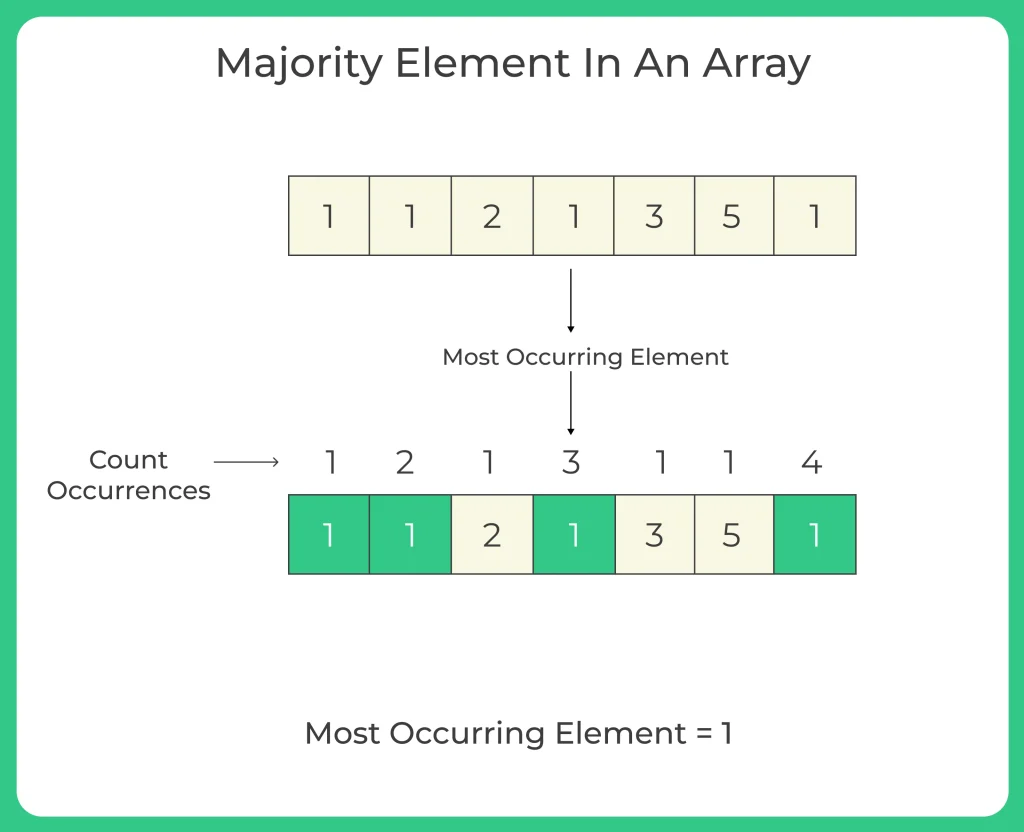Majority Element in an Array in C++
Majority Element in array in C++ Language
In this page we will look into a coding question where we will learn how to find the element which occurs majority number of times in array in C++ Programming Language. There might be different approach to solve this question, one you will find here. If your approach is bit different post it onto the comment section.
Majority Element In An Array In C++
The Boyer-Moore Majority Vote Algorithm is a widely used algorithm for finding the majority element in an array. The majority element in an array in C++ is an element that appears more than n/2 times, where n is the size of the array.
This Algorithm is efficient with a time complexity of O(n) and a space complexity of O(1), as it uses constant extra space to maintain the candidate and count variables. It is a clever algorithm that leverages the properties of majority elements to find them efficiently in linear time.

Algorithm
- Initialize a variable
candidateto store the candidate element, and set it to the first element of the arrayarr[0]. - Initialize a variable
countto store the count of occurrences of the candidate element, and set it to 1. - Iterate through the array
arrfrom index 1 to n-1:- If
countis 0, set the current element as the new candidate element and incrementcountto 1. - If the current element is equal to the candidate element, increment
countby 1. - If the current element is not equal to the candidate element, decrement
countby 1.
- If
- Reset
countto 0. - Iterate through the array
arragain to verify if the candidate element is a majority element:- If the current element is equal to the candidate element, increment
countby 1.
- If the current element is equal to the candidate element, increment
- If
countis greater than n/2, return the candidate element as the majority element. - If no majority element is found, return -1.
Program for finding the element that occurs most time in an array
#include <iostream> using namespace std; int findMajorityElement (int arr[], int n) { int candidate = 0; // Candidate for majority element int count = 0; // Count of occurrences of candidate element // Candidate selection phase for (int i = 0; i < n; i++) { if (count == 0) { candidate = arr[i]; // Set current element as candidate count = 1; } else if (arr[i] == candidate) { count++; } else { count--; } } // Verification phase count = 0; for (int i = 0; i < n; i++) { if (arr[i] == candidate) { count++; // Count occurrences of candidate element } } if (count > n / 2) { return candidate; } else { return -1; // No majority element found } } int main () { int arr[] = { 3, 3, 4, 2, 4, 4, 2, 4, 4 }; // Example array int n = sizeof (arr) / sizeof (arr[0]); int majorityElement = findMajorityElement (arr, n); if (majorityElement != -1) { cout << "Majority element is: " << majorityElement << endl; } else { cout << "No majority element found" << endl; } return 0; }
Output
Majority Element = 4
Prime Course Trailer
Related Banners
Get PrepInsta Prime & get Access to all 200+ courses offered by PrepInsta in One Subscription
Get over 200+ course One Subscription
Courses like AI/ML, Cloud Computing, Ethical Hacking, C, C++, Java, Python, DSA (All Languages), Competitive Coding (All Languages), TCS, Infosys, Wipro, Amazon, DBMS, SQL and others
Introduction to Trees
Binary Trees
- Binary Tree in Data Structures (Introduction)
- Tree Traversals: Inorder Postorder Preorder : C | C++ | Java
- Inorder Postorder PreOrder Traversals Examples
- Tree Traversal without Recursion
Binary Search Trees
Traversals
- Traversal in Trees
- Tree Traversals: Breadth-First Search (BFS) : C | C++ | Java
- Tree Traversals: Depth First Search (DFS) : C | C++ | Java
- Construct a Binary Tree from Postorder and Inorder
B – Trees
AVL Trees
- AVL Trees
Complete Programs for Trees
- Depth First Traversals – C | C++ | Java
- Level Order Traversal – C | C++ | Java
- Construct Tree from given Inorder and Preorder traversals – C | C++ | Java
- Construct Tree from given Postorder and Inorder traversals – C | C++ | Java
- Construct Tree from given Postorder and Preorder traversal – C | C++ | Java
- Find size of the Binary tree – C | C++ | Java
- Find the height of binary tree – C | C++ | Java
- Find maximum in binary tree – C | C++ | Java
- Check whether two tree are identical- C| C++| Java
- Spiral Order traversal of Tree- C | C++| Java
- Level Order Traversal Line by Line – C | C++| Java
- Hand shaking lemma and some Impotant Tree Properties.
- Check If binary tree if Foldable or not.- C| C++| Java
- check whether tree is Symmetric – C| C++| Java.
- Check for Children-Sum in Binary Tree- C|C++| Java
- Sum of all nodes in Binary Tree- C | C++ | Java
- Lowest Common Ancestor in Binary Tree- C | C++ | Java
Introduction to Trees
Binary Trees
- Binary Tree in Data Structures (Introduction)
- Tree Traversals: Inorder Postorder Preorder : C | C++ | Java
- Inorder Postorder PreOrder Traversals Examples
- Tree Traversal without Recursion
Binary Search Trees
Traversals
- Traversal in Trees
- Tree Traversals: Breadth-First Search (BFS) : C | C++ | Java
- Tree Traversals: Depth First Search (DFS) : C | C++ | Java
- Construct a Binary Tree from Postorder and Inorder
B – Trees
AVL Trees
- AVL Trees
Complete Programs for Trees
- Depth First Traversals – C | C++ | Java
- Level Order Traversal – C | C++ | Java
- Construct Tree from given Inorder and Preorder traversals – C | C++ | Java
- Construct Tree from given Postorder and Inorder traversals – C | C++ | Java
- Construct Tree from given Postorder and Preorder traversal – C | C++ | Java
- Find size of the Binary tree – C | C++ | Java
- Find the height of binary tree – C | C++ | Java
- Find maximum in binary tree – C | C++ | Java
- Check whether two tree are identical- C| C++| Java
- Spiral Order traversal of Tree- C | C++| Java
- Level Order Traversal LIne by Line – C | C++| Java
- Hand shaking lemma and some Impotant Tree Properties.
- Check If binary tree if Foldable or not.- C| C++| Java
- check whether tree is Symmetric C| C++| Java.
- Check for Children-Sum in Binary Tree- C|C++| Java
- Sum of all nodes in Binary Tree- C | C++ | Java
- Lowest Common Ancestor in Binary Tree. C | C++ | Java






Login/Signup to comment